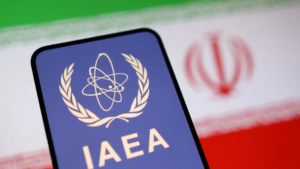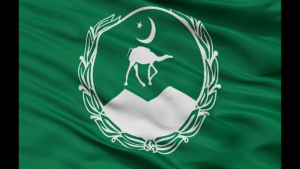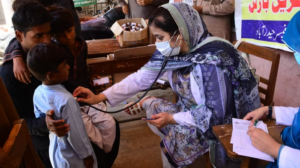The International Monetary Fund (IMF) has approved a $7 billion loan for Pakistan aimed at helping the South Asian nation stabilize its economy. After assuming power earlier this year, Pakistan’s new coalition government led by the Pakistan Muslim League-Nawaz (PML-N) had approached the IMF for the 25th time for a loan. On September 12, Pakistani Prime Minister Shehbaz Sharif said his country had met all the conditions set by the IMF to qualify for a new loan. And on September 25, the IMF signed a formal approval of the loan.
USIP’s Sanjay Kathuria and Asfandyar Mir and economic analyst Shahbaz Rana discuss the significance of the IMF’s latest package, whether it will help Pakistan out of its economic crisis, and its domestic political and foreign policy implications.
Pakistan approached the IMF for the 25th time this year, as the last program it entered in 2019 went completely off track and the country’s economic crisis deepened. Ever since, the country has faced anemic economic growth, high inflation and rising poverty. Last year, the country’s economic growth was down to 2.4 percent — which was lower than the population growth rate of 2.6 percent. This was in the backdrop of a large budget deficit and an increasingly challenging debt burden. Tax collection remained weak, with revenues at only 12 percent of GDP while expenditures were around 20 percent. The energy sector and state-owned enterprises also continued to hemorrhage. Most significantly, Pakistan’s external account — the combination of foreign exchange reserves and external debt repayment — was severely challenged due to low exports and foreign direct investment, coupled with high import dependency. This brought a near-default-like situation in 2023, which was averted by an emergency stopgap arrangement with the IMF in mid-2023 that ended earlier this year.
To deal with the persistent bleak macroeconomic picture as well as an unresolved balance of payments crisis going forward, Pakistan had no option but to return to the IMF for another bailout. This time, as part of a $7 billion multiyear program, Pakistan has committed to several policy changes that both the IMF and Pakistan hope will prevent the repeat of the last failed program. The thrust of the new program is to get fiscal policies right. These include bringing retail, agriculture and export sectors into the normal income tax regime by the imposition of massive tax increases and abolishing of exemptions. Pakistan’s federal and provincial governments are also slated to sign a new national fiscal pact to improve their coordination on spending and improve fiscal discipline. Overall, the IMF is pushing for additional tax measures equal to 3 percent points of GDP under the program and — despite the political challenges of implementing such a major increase in taxation — Pakistan has agreed to that.
Bangladesh, Pakistan and Sri Lanka are at different levels of macroeconomic stress and vulnerability, each addressing unique challenges with the support of IMF programs. Pakistan’s recurrent crises have taken it to the IMF a record 25 times, including the recently approved Extended Fund Facility. Core elements of the new program include broadening and rationalizing taxes, addressing energy sector viability and supporting reforms relating to the foreign exchange market, social protection, state-owned enterprises and private sector development.
Sri Lanka is the second-most frequent IMF borrower amongst South Asian countries, with 17 programs so far. Like Pakistan, it is in the midst of an economic crisis that culminated in an external debt default in April 2022. In March 2023, Sri Lanka began a new, four-year program to help anchor its long road back to debt sustainability. Sri Lanka was making progress under the program, including positive growth for three consecutive quarters. However, the recent election of Anura Dissanayake as president and his promise to reassess debt sustainability under the program has created some uncertainty, at least about the timing of future tranche releases.
Bangladesh’s fundamentals, despite recent stresses and the change in administration, are stronger than Pakistan’s or Sri Lanka’s. Its IMF program, approved in January 2023, was essentially a precautionary one that sought to rebuild buffers. However, the quota protests and unrest in July-August 2024 have created additional stresses in the economy. The new administration is now seeking additional support from the IMF, World Bank, and the ADB, among other partners.
Similarities across the IMF programs of Pakistan, Sri Lanka and Bangladesh include fiscal consolidation, rebuilding a comfortable level of foreign exchange reserves and enhancing social protection measures to support the poor and vulnerable.
But the differences between the programs are more interesting. Unlike Sri Lanka, Bangladesh’s 2023 IMF program did not follow a crisis. It was a preemptive strike. Bangladesh’s IMF program supports some long-term issues, such as capital investment targets and reform measures on climate change. By contrast, Sri Lanka’s program focuses on debt sustainability, including debt restructuring. Here, the IMF is of great help, facilitating debtor-creditor engagement and, by providing debt-related targets in the program, setting expectations and benchmarks for debt negotiations. Pakistan, on the other hand, has been lurching from one crisis to another without its core underlying problems getting addressed. For example, the energy sector and its large fiscal burden have been a constant feature of not only IMF but also World Bank programs.
The new IMF program for Pakistan aims to stabilize the country’s economy, but its potential to drive long-term growth and development remains uncertain. While the program addresses some critical issues like broadening the tax base and improving government transparency, it does not tackle the structural problems in Pakistan’s economy.
For example, the program is focused on increasing revenues, but it doesn’t address government spending issues — one of the key issues in Pakistan’s economy. The Pakistani government continues to borrow excessively from domestic sources for spending on development and nondevelopment expenses, which has driven an out-of-control domestic debt and interest repayment problem — over half of Pakistan’s annual budget is spent on interest payments. Spending on political patronage is another core area of concern. Another structural problem lies in Pakistan’s energy sector. The IMF program is focused on further energy tariff hikes — as part of improving revenue collection — without overhauling energy cost structure. Moreover, the program’s emphasis on stabilization will increase the cost of production in the country, which could hinder industrial growth and exports. That may keep Pakistan dependent on external financial support instead of weaning it away.
Nevertheless, some gains are possible under the new program, as it will ensure a degree of stabilization. However, these gains depend on the Pakistani government’s commitment to implementing the agreed-upon reforms, especially in the face of political backlash to the taxation measures and subsidy removals.
The program is much needed, but Pakistan also needs to go beyond program prescriptions to break out of the IMF rescue cycles. Its core economic challenges center around debt sustainability and long-term competitiveness. Debt servicing imposes a huge burden on Pakistan’s revenues, foreign earnings and, ultimately, its people. Interest payments alone are estimated by the IMF at about 68 percent of tax revenue in FY 2023. Gross external financing needs for FY 2024 to FY 2029 could be as high as about $146 billion, evidenced in recurrent scrambling by Pakistan’s leaders to secure or roll over foreign loans. Pakistan needs to seriously consider debt restructuring, carefully weighing its pros and cons. The alternative would be uncertainty and low and volatile growth.
Chinese debt will certainly complicate debt restructuring should Pakistan contemplate that route, since China is Pakistan’s biggest external creditor. Chinese bilateral credit alone, at $23.6 billion, is bigger than total World Bank debt of $20.1 billion (FY 2023 end), and total Chinese lending amounts to over 28 percent of Pakistan’s total external public debt. While China is a reluctant participant in international debt restructuring discussions, a recent restructuring agreement between China’s Exim Bank and Sri Lanka holds out hope for possible similar discussions between Pakistan and China.
Another complication is that domestic debt is almost 60 percent of Pakistan’s total public debt. Restructuring domestic debt is politically more difficult than foreign debt, but it can be done, as Sri Lanka’s recent example shows. To avoid frequent balance of payments crises, Pakistan has to also strengthen exports and competitiveness. This is a massive agenda, not easily tackled, and involves injecting more competition in the economy, engineering a deep trade relationship with India, rationalizing import taxes, improving the business environment and broadening the tax base, among others.
Many of these reforms will come up against entrenched business interests. Only a homegrown economic program can address and tackle the political economy of far-reaching reforms. The IMF program can, however, provide a useful anchor for some critical issues, including debt restructuring (if Pakistan follows Sri Lanka in that respect), and, along with the World Bank and Asian Development Bank, support some elements of the long-term competitiveness agenda.
The approval of the IMF program will politically benefit the ruling coalition. For one, the program will provide macroeconomic stability and confidence to Pakistan’s economic partners — like China, Saudi Arabia and the United Arab Emirates, who link economic help and investment to Pakistan staying on in an IMF program. This is politically significant for the PML-N-led coalition government. When it was formed earlier in the year, the government was viewed as too weak and fragmented to forge a united front for implementing meaningful economic policy measures. The fact that it agreed to various economic adjustments and convinced the IMF on a new program on the timeline Pakistan needed an IMF program suggests it has more political weight than was initially recognized. And with a long-term program in place, it can signal that the macroeconomic crisis the country experienced over the last two years is now behind it — which creates political space for the government. The program’s timely approval also validates the PML-N’s politically challenging decision to appoint a technocrat from outside the party fold, Muhammad Aurangzeb, as finance minister in place of former Finance Minister Ishaq Dar, who struggled to negotiate with the IMF in his last stint.
At the same time, the IMF-mandated economic adjustments are unpopular and seen as unfair by many Pakistanis. There is a widespread view that the new tax measures and subsidy removals, especially on electricity, are disproportionately affecting the already burdened working classes, and the elite and rent-seeking classes have obtained carve outs of exemptions and special treatment. Thus, even as macroeconomic stability will help the government, the sentiment that Pakistani elite have once again evaded pain will be a source of anger against the government. How the two countervailing political effects — the positive impact of the macro stability and the pain of IMF-mandated reforms — will net out is hard to predict with certainty. It is possible that after back-to-back years of economic turbulence, economic certainty, on the back of global oil prices falling and increase in foreign remittances, will bring stability and dilute, if not outright outweigh, the negative effects of unpopular economic policies.
Beyond domestic politics, Pakistan’s engagements with the IMF are also enmeshed in the country’s foreign relations. For the last couple of years, Pakistani leadership has worried, at times even publicly, that the United States is using the IMF as a tool of geopolitical pressure, partly due to Pakistan’s relationship with China. This view was one of the main theories in Islamabad on why Pakistan was unable to get an IMF tranche cleared in the first half of 2023. Right or wrong, the approval of the new program will be read as a sign in Pakistan and the region that the United States, as the largest shareholder at the IMF, supported Pakistan’s IMF program, which will ease tensions in U.S.-Pakistan bilateral ties. On the other hand, China’s generous external financing assurances and debt rollovers were also critical to Pakistan obtaining the program, which reinforces the macro-economic pillar of the China-Pakistan relationship and adds to China’s influence.
Finally, in Washington, Pakistan’s return to a long-term IMF program will be viewed as a welcome development. Pakistan’s economic stability is important for U.S. regional policy and counterterrorism goals, especially at a time when ISIS-K and the TTP are major threats. Thus, amid the stress of the security situation due to terrorist violence in western Pakistan, policymakers will see the IMF’s stewardship of Pakistan’s economy as reducing the risk of a convergence of escalating terrorism and an economic meltdown.






